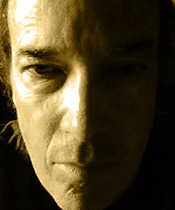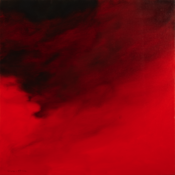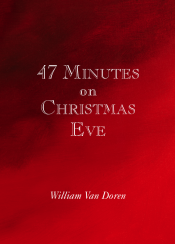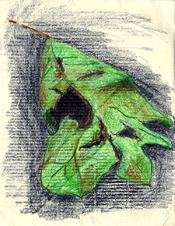 William Theodore Van Doren. Sunset from Stony Point, Albemarle County, Va. Oil on watercolor block, 16 x 20.
William Theodore Van Doren. Sunset from Stony Point, Albemarle County, Va. Oil on watercolor block, 16 x 20.
Clear tonight, or nearly so.
On this >1,000-acre place we inhabit as renters there are, to our knowledge, four persimmon trees, and every year we watch as the fruit ripens and taunts us with our inability to make proper use of it.
If you were to look up persimmons online, and find them, say, on a cooking website, you’d think, hey, what’s the problem, there are plenty of ways to use persimmons!
But, ironically – even though our English word ‘persimmon’ originates with the Powhatan tribe of Virginia – what most people now mean when they discuss persimmons are two Asian varieties, and these are the kind you can find in supermarkets.
In fact, ‘fresh grocer’ Tony Tantillo cautions you to be aware that there is not one, there are TWO (as if there were just two) varieties of persimmon:
... the Fuyu, the kind you can eat right away, and the Hachiya, the kind you can’t. If you bite into an unripe Hachiya persimmon, it is as if you just drank six cups of extra strength tea. This astringent flavor is due to the high level of tannin in the fruit, and there is a good chance that you would never try a persimmon again because it tastes so bitter.
That’s fine as far as it goes, but even the Hachiya is a sweetie pie compared with the persimmons that gave persimmons their name – persimmons with virginiana in their Latin title. And these guys, these eastern, country, American persimmons, are tough to deal with.
Let’s put it this way. I’ve long been aware that you were supposed to let our persimmons go past the frost. They start out green and hard, then ripen to orange, softening, and then, after a hard frost, they turn a bit darker, even somewhat blue in places, and very soft – and then you’re supposed to be able to eat them.
I don’t think so!
‘Astringent’ doesn’t do them justice. Ever seen those joke photos of some old guy, seemingly with no teeth, his lips and mouth and cheeks so puckered up it looks like he’s swallowed them? That’s what it feels like.
I’ve tried various ways of using them, including a really interesting recipe in one of my favorite ‘old’ (1970s-era) books, still available, Putting It Up With Honey: A Natural Foods Canning and Preserving Cookbook, by Susan Geiskopf ... Geiskopf was in California when she wrote the book and I think that recipe needs one of the Asian varieties.
As for virginiana, I figured the thing to do might be to add sugar or honey and strong spices and try to make a sort of chutney. I gave up on my last attempt, before Thanksgiving, partly because of flavor failures and partly because of the two huge flat seeds that take up so much of each persimmon.
Precisely because of those unmistakable seeds, I can report one discovery I made out in the fields today. Even though persimmons are coming along rather late, and aren’t yet even entirely orange, much less soft, bears – who must possess mouths of steel (and iron constitutions) – seem to have no problem with them whatsoever.
 William Theodore Van Doren. Stony Point, Albemarle County, Va. Oil on paper, 16 x 20.
William Theodore Van Doren. Stony Point, Albemarle County, Va. Oil on paper, 16 x 20. Saturday, November 28, 2009 at 05:46PM | by
Saturday, November 28, 2009 at 05:46PM | by  BVD | in
BVD | in  Sunset Paintings | tagged
Sunset Paintings | tagged  Blue Ridge,
Blue Ridge,  Native Americans,
Native Americans,  frost,
frost,  persimmons | | Comments Off
persimmons | | Comments Off 








On the Origins of ‘Indian Summer’
Now we have Indian Summer, for maybe three days, starting yesterday. The closest thing to an official definition of this unofficial, undefined phenomenon is any autumn day over 70°F after the first frost. Sometimes this is supposed to mean the first killing frost, but lately I’ve been cheating and just any widespread frost will do.
You can read a lot of very interesting stuff about Indian Summer, presented in painfully uninteresting fashion, on the globalinterspiderweb, for example in the Wikipedia entry and in a USA Today piece borrowed, it seems, from a regional office of the U.S. Weather Service. The article by the Weather Service historian is particularly nice in its descriptions of Indian Summer.
It’s in trying to account for the term’s origins that these sources and others get a little strange. I can’t say that the sources are wrong, only that there’s a highly suspicious disconnect between the supposed etymology and the way the term is used – its sensual, emotional, even poetic connotations. I realize that such disconnects are common in etymology – a term often ends up meaning something completely divorced from its original context. But this is a case where other, better explanations are sitting right there at hand.
Maybe somehow, at some point, ‘Indian Summer’ really did have something to do with a period of the year when Indians were more likely to attack colonists, or colonists were likely to attack Indians (two of the leading theories). Maybe it really even derived from the ‘I.S.’ line marked on the outside of sailing ships – denoting the safe level to which one could load cargo for the Indian Ocean in the summer, i.e., Indian [Ocean] Summer [Level]. But somehow such explanations strike me as a triumph of mechanistic ‘history detective’ logic over common sense.
My theory, which isn’t all that theoretical, takes into account that, among the many terms for similar autumnal warm spells in other cultures, there’s also a ‘Gypsy Summer’, in southeastern Europe. I think the name must somehow be related to the mellow perfection of the weather and the sense of ease and well-being it tends to produce. At times like these, even you or I might be capable of living simply and directly, outdoors, like a native American or one of the Romani people. Not that I believe this exact thought is the source of the term, but it’s easy to associate such beneficent conditions with the people who live in the woods and fields. On an Indian Summer day, there’s no need for shelter from the rain, summer insects have been nipped by the frost, there’s neither the broiling heat of August nor the cold wet snow of February – it’s the kind of day when civilized or technological intervention is least needed and in fact only gets in the way.
Or I would put it like this: On a mild day in late October or early November, sit and face the sun, down out of the wind, in the tall dry grasses, your back against a line of trees. The sun turns you into a checkerboard of alternating squares of light and self. After a while you don’t know where you end and the sun begins. That’s because there is no such place. At that moment, any one of us is a true aboriginal of this splendid world.